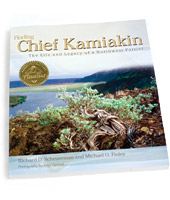Finding Chief Kamiakin
Professor’s Book Chosen as Finalist for the Washington State Book Award

Richard Scheuerman and co-author Michael O. Finley offer a portrait of a prominent, mid-19th-century, Native American leader described as “the strongest personality of
his time west of the Rocky Mountains.” |
When he saw the sign that read “COLVILLE INDIAN RESERVATION, NORTH 20 MILES,” Richard Scheuerman took a right turn off of the highway.
That was almost 40 years ago. But Scheuerman, now an assistant professor of curriculum and instruction at Seattle Pacific University, is still following his curiosity.
For generations, the story of Chief Kamiakin (1800–77), a leader of Native Americans from the Yakima, Palouse, and Klickitat tribes who bravely represented his people through an era of “unprecedented cultural onslaught,” was missing from history books. Now anyone can read about his influential role, thanks to Scheuerman and co-author Michael O. Finley, a member and now council chair of the Colville Confederated Tribes. Their collaboration — a book titled Finding Chief Kamiakin: The Life and Legacy
of a Northwest Patriot (Washington State University Press, 2008) — was named a finalist for the 2009 Washington State Book Award for Nonfiction.
The project began in 2005, when Finley penned a letter to Scheuerman. Finley, working with the Colville Tribal History Office, wanted to learn from Scheuerman’s research to help provide school curriculum resources. “Had it not been for Michael reaching out to me, I’m not sure the book would have come to pass,” says Scheuerman.
 Raised in the rural Palouse Hills of Eastern Washington, Scheuerman grew up listening to his grandfather’s stories about their Russian-German family origins, and about the region’s Native American history. This kindled his interest, and when he spotted that Colville Reservation road sign on an afternoon in 1970, he said, “Hey, Grandpa, what do you think about taking a little trip?” When they pulled up to the reservation office, Scheuerman marched inside. Raised in the rural Palouse Hills of Eastern Washington, Scheuerman grew up listening to his grandfather’s stories about their Russian-German family origins, and about the region’s Native American history. This kindled his interest, and when he spotted that Colville Reservation road sign on an afternoon in 1970, he said, “Hey, Grandpa, what do you think about taking a little trip?” When they pulled up to the reservation office, Scheuerman marched inside.
“I asked if there were any elders who’d be willing to visit with me,” says Scheuerman. The woman at the desk happened to be Annie George, granddaughter of Chief Kamiakin. She directed him up the road for a front-porch meeting with Kamiakin’s grandson Arthur Tomio, and Scheuerman asked the first questions in an investigation that would span decades.
He became acquainted with guardians of the Kamiakin family and tribal history, including a 100-year-old Native American woman named Isabel Arcasa, and her “auntie,” Emily Peone.
When he became a teacher, Scheuerman brought students along to help in the research. “I’m a great advocate of what I call ‘transgenerational learning,’” says Scheuerman, “getting young people connected with elders.”
Detail by detail, Scheuerman drew out the dramatic history of how the Kamiakin family was able to hold on to pieces of their homeland. The story, he says, is “a singular example of the tragedy and triumph of the Native American experience in the Northwest.”
—By Jeffrey Overstreet [jeffreyo@spu.edu]
—Photo courtesy of the George Pullen Jackson Archives
Also read about the Washington State Book Award in Nonfiction, won by SPU instructor Robert Clark.
Back to the top
Back to Books & Film Home
|